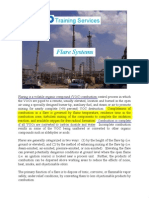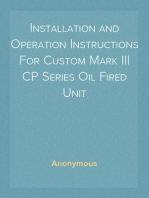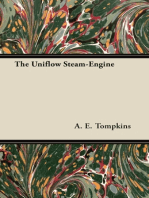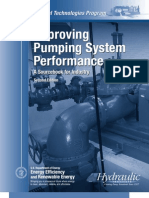1.2 Flare Design Specification Pt.2: Utilities
Uploaded by
emilliomud1.2 Flare Design Specification Pt.2: Utilities
Uploaded by
emilliomud1.2 Flare Design Specification Pt.
2
Utilities
When generating a flare specification it is important to detail the available utilities. All flares should be
continuously purged to prevent oxygen ingress into the flare riser and fitted with continuous PILOT burners
to provide a reliable source of ignition. As such the purge and pilot gas supply should be from a reliable
source.
The composition of the available purge gas, the flare riser size and FLARED gas composition will determine
the purge rate and this will be determined by the flare vendor.
The PILOT gas consumption will also be determined by the flare vendor and is also directly related to the
flare size.
Where smokeless combustion is REQUIRED and cannot be achieved through the available
energy/momentum of the flared gas stream, it will be necessary to use an assist medium such as air or steam.
Steam is the most common medium and generally readily available on a refinery. It is typically injected
through numerous specially designed nozzles connected to a steam manifold attached to the flare tip. Air
assist flares utilise a large volume of low pressure air generated by an air blower which is mixed with the gas at
the tip.
Location
The location and elevation of the flare is a key design consideration determined largely by the allowable
radiation. On onshore facilities the decision is frequently governed by its proximity to other process
equipment, plant boundaries, prevailing wind direction and the cost of the associated support
structure. OFFSHORE the options are limited to platform mounted flare tower, bridge linked tower or flare
boom. Recommended radiation design limits are provided in API 521.
Site conditions such as wind direction, SOLAR radiation, humidity etc. all have an affect on the exhibited
radiation and therefore should also be communicated to the flare vendor during the design phase. Radiation
shielding on offshore platforms is common place in order to further protect adjacent process plant and
walkways. Water sprays have also been used.
2.1 Pipe Flares
Typical UTILITY Pipe Flare
Our basic subsonic utility flare typically operates at a pressure of less than 0.7 barg. This type of flare is the
work horse of the flare industry and is found in most locations where flaring occurs. They are relatively easy
to manufacture and provide a good reliable method of low pressure gas disposal whether by venting or
flaring. Our pipe flare provides the operators with A SIMPLE , robust and reliable flare tip that will typically
exhibit long life time. We can supply new bespoke flare tips or refurbishments of other OEM flares to suit the
operators specific platform or site conditions.
Flare Tip
The standard flare tip is fabricated in heat resistant 316L SS, 310S STAINLESS STEEL or 800H
materials. Upgrades to higher heat resistant materials are also available when the operating conditions are
more onerous than normal. The main body consists of a single pipe, wind deflectors, and flame stabilisers. A
purge reduction seal is also included just above the main gas inlet flange and presents a physical barrier to
back-flow of air at the inner tip wall. In addition, the seal maximises the velocity of the purge gas in the open
centre of the riser, further reducing the risk of air ingress into the flare stack.
Pilots and Igniters
The flare tip is normally fitted with pilots manufactured in heat resistant steel, incorporating a nozzle designed
for maximum pilot flame stability, an inspirator assembly for regulating the air and gas mixture to the pilot and
the igniter which fits into the nozzle directly. An interface flange is typically provided on the pilot inlet piping
for CONNECTION to the fuel gas pipe manifold. The tip is equally capable of being ignited with a Flame
Front, High Energy, High Tension or Pellet type ignition system.
Our pipe flares are always designed with FLAME stability in mind
Flame Stability
The key thing is to ensure that the flare tip remains ignited at all times at both low and high flow RATES in
high cross winds. Good flame stabiliser design using either angled lugs situated around periphery of the tip
exit or a concentric type insert coupled with efficient pilots will achieve this across all operating and
atmospheric conditions.
Typical Pipe Flare Information
Size
8 NB 12 NB 18 NB 24 NB 30 NB 36 NB
TYPICAL Length (m)
2.0 2.5 3.0 3.0 3.0 3.0
* Purge RATES are typical for fuel gas with a 60% diode type purge reduction seal.
** Purge RATES are typical for nitrogen with a 60% diode type purge reduction seal.
*** Typical capacity at 0.5 Mach with a molecular weight of 25 kg/kgmol and an operating temperature of
30C.
Typical Qty Pilots
2 2 or 3 3 3 3 3
Typical Weight (kg)
180 300 485 700 1000 1225
Typical Fuel Gas Purge Rate
(Nm/h)*
0.94 2.28 5.1 9.9 17.0 27.0
Typical Nitrogen Purge Rate
(Nm/h)**
0.73 1.77 3.9 7.7 13.2 21.0
Typical Capacity (kg/h)***
18,300 48,800 99,500 179,000 283,000 410,000
You might also like
- Lincoln Manual-Part Book VANTAGE 500 11467 PDF100% (4)Lincoln Manual-Part Book VANTAGE 500 11467 PDF76 pages
- Flare System Design For Oil and Gas Installations Chris Park100% (1)Flare System Design For Oil and Gas Installations Chris Park43 pages
- TM 9-2350-247-24P M548a1 NSN 2350-01-096-9356 and M548a3 NSN 2350-01-369-6081No ratings yetTM 9-2350-247-24P M548a1 NSN 2350-01-096-9356 and M548a3 NSN 2350-01-369-6081802 pages
- O U Mohamed Ismail (R670215011) .ProtectedNo ratings yetO U Mohamed Ismail (R670215011) .Protected77 pages
- Retrofitting The Existing Flare / Burnery For Smoke Less OperationsNo ratings yetRetrofitting The Existing Flare / Burnery For Smoke Less Operations31 pages
- Flares in Refineries and Chemical Plants - Industry Standards and US Emissions Regulations100% (3)Flares in Refineries and Chemical Plants - Industry Standards and US Emissions Regulations31 pages
- ENGINEERING DESIGN GUIDELINES Flare Systems Rev3.4webNo ratings yetENGINEERING DESIGN GUIDELINES Flare Systems Rev3.4web25 pages
- ENGINEERING DESIGN GUIDELINES Flare Systems Rev3.4web100% (1)ENGINEERING DESIGN GUIDELINES Flare Systems Rev3.4web25 pages
- Flare Systems Basics Design and Calculations 1678330360100% (3)Flare Systems Basics Design and Calculations 167833036063 pages
- Flare System Awareness Design and Calculation100% (1)Flare System Awareness Design and Calculation54 pages
- Engineering Design Guidelines Flare Systems Rev3.4webNo ratings yetEngineering Design Guidelines Flare Systems Rev3.4web25 pages
- Flares - Types, Parts, Components, Operation and TroubleshootingNo ratings yetFlares - Types, Parts, Components, Operation and Troubleshooting27 pages
- Flare System: Types, Segregation, Tips, Purge System and More100% (2)Flare System: Types, Segregation, Tips, Purge System and More23 pages
- Use of Variable Frequency Drives For Better Destruction Efficiency of Air-Assisted Flares - University of Utah Partnerships - J. Willard Marriott Digital LibraryNo ratings yetUse of Variable Frequency Drives For Better Destruction Efficiency of Air-Assisted Flares - University of Utah Partnerships - J. Willard Marriott Digital Library20 pages
- Flare Selection and Sizing HTTP Kolmetz - Com PDF EDG En... IDELINE - 20flare 20rev1.150% (2)Flare Selection and Sizing HTTP Kolmetz - Com PDF EDG En... IDELINE - 20flare 20rev1.119 pages
- E-Pr-460 Process Design Flare and Blowdown Vessels100% (1)E-Pr-460 Process Design Flare and Blowdown Vessels37 pages
- Installation and Operation Instructions For Custom Mark III CP Series Oil Fired UnitFrom EverandInstallation and Operation Instructions For Custom Mark III CP Series Oil Fired UnitNo ratings yet
- Contemporary Anaesthetic Equipments.: An Aid for Healthcare ProfessionalsFrom EverandContemporary Anaesthetic Equipments.: An Aid for Healthcare ProfessionalsNo ratings yet
- Encyclopaedia Britannica, 11th Edition, Volume 8, Slice 3 "Destructors" to "Diameter"From EverandEncyclopaedia Britannica, 11th Edition, Volume 8, Slice 3 "Destructors" to "Diameter"No ratings yet
- CEE 5134 Deoxygenation - Reaeration and The The Streeter-Phelps EquationNo ratings yetCEE 5134 Deoxygenation - Reaeration and The The Streeter-Phelps Equation35 pages
- Carbothane 134 Za (April 2013 Replaces November 2012)No ratings yetCarbothane 134 Za (April 2013 Replaces November 2012)2 pages
- The Strategic Use of Liquid Lime in Sludge Treatment: - Case StudyNo ratings yetThe Strategic Use of Liquid Lime in Sludge Treatment: - Case Study19 pages
- Hotel/Site Directory & Checklist: Profile of Convention WeekNo ratings yetHotel/Site Directory & Checklist: Profile of Convention Week2 pages
- TQ-5133502 TQ-5133501A TQ-5133503: D.O. Service TK P D.O. Settling TK S D.O. Storage TK SNo ratings yetTQ-5133502 TQ-5133501A TQ-5133503: D.O. Service TK P D.O. Settling TK S D.O. Storage TK S1 page
- Model 210 Digital Electro-Hydraulic Set Stop - PDF-, AttachmentNo ratings yetModel 210 Digital Electro-Hydraulic Set Stop - PDF-, Attachment4 pages
- 7132249A.01 Analyzer System Manual V1.0 (Kiln Inlet)No ratings yet7132249A.01 Analyzer System Manual V1.0 (Kiln Inlet)26 pages
- Petroleum and Adulteration: A Forensic Guide For Crime InvestigatorsNo ratings yetPetroleum and Adulteration: A Forensic Guide For Crime Investigators19 pages
- Combined Driller Equipment Paper NO. 2.: All Questions Require Only ONE Answer Unless Otherwise Stated100% (2)Combined Driller Equipment Paper NO. 2.: All Questions Require Only ONE Answer Unless Otherwise Stated23 pages
- Sei Gelam Peaker 11xw20v34sg Engine Spares 2012 DocuNo ratings yetSei Gelam Peaker 11xw20v34sg Engine Spares 2012 Docu6 pages
- Dial Me Liquefied Petroleum Gas and DeliveryNo ratings yetDial Me Liquefied Petroleum Gas and Delivery74 pages
- Ethylene Recovery Through Dephlegmator Technology100% (1)Ethylene Recovery Through Dephlegmator Technology9 pages
- Lampiran Jurnal Process Simulation and Optimization of Crude Oil Stabilization Scheme Using Aspen Hysys SoftwareNo ratings yetLampiran Jurnal Process Simulation and Optimization of Crude Oil Stabilization Scheme Using Aspen Hysys Software11 pages



































































































